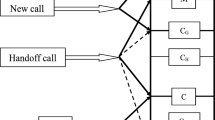Abstract
The channel assignment problem (CAP), the task to assign the required number of channels to each radio cell in such a way that interference is precluded and the frequency spectrum is used efficiently, is known to be an NP-complete optimization problem. In this paper, we solve CAP using a stochastic chaotic neural network that we proposed recently. The performance of stochastic chaotic simulated annealing (SCSA) is compared with other algorithms in several benchmark CAPs. Simulation results showed that this approach is able to further improve on results obtained by other algorithms.
Access this chapter
Tax calculation will be finalised at checkout
Purchases are for personal use only
Preview
Unable to display preview. Download preview PDF.
Similar content being viewed by others
References
A. Gamst and W. Rave, “On frequency assignment in mobile automatic telephone systems,” Proc. GLOBECOM’82, pp. 309–315, 1982.
D. Kunz, “Channel assignment for cellular radio using neural networks”, IEEE Trans. Veh. Technol., vol. 40, no. 1, pp. 188–193, 1991.
K. N. Sivarajan, R. J. McEliece and J. W. Ketchum, “Channel assignment in cellular radio”, Proc. 39th IEEE Veh. Technol. Soc. Conf., pp. 846–850, May, 1989.
A. Gamst, “Some lower bounds for a class of frequency assignment problems”, IEEE Trans. Veh. Tech., vol. VT-35, pp. 8–14, Feb., 1986.
W. K. Hale, “Frequency assignment: theory and application”, Pro. IEEE, vol. 68, pp. 1497–1514, Dec., 1980.
M. Duque-Anton, D. Kunz, and B. Ruber, “Channel assignment for cellular radio using simulated annealing”, IEEE Trans. Veh. Technol., vol. 42, no. 1, February, 1993.
S. Geman and D. Geman, “Stochastic relaxation, Gibbs distributions, and the Bayesian restoration of images”, IEEE Trans. Pattern Analysis and Machine Intelligence, vol. 6, pp. 721–741, 1984.
K. Smith and M. Palaniswami, “Static and dynamic channel assignment using neural network”, IEEE Journal on Selected Areas in Communications, vol. 15, no. 2, Feb., 1997.
N. Funabiki and Y. Takefuji, “A neural network parallel algorithm for channel assignment problems in cellular radio networks”, IEEE Trans. Veh. Technol., vol. 41, no. 4, November, 1992.
P. Chan, M. Palaniswami and D. Everitt, “Neural network-based dynamic channel assignment for cellular mobile communication systems”, IEEE Trans. Veh. Technol., vol. 43, no. 2, May, 1994.
J. Kim, S. H. Park, P. W. Dowd and N. M. Nasrabadi, “Cellular radio channel assignment using a modified Hopfield network”, IEEE Trans. Veh. Technol., vol. 46, no. 4, November, 1997.
L. Chen and K. Aihara, “Chaotic simulated annealing by a neural network model with transient chaos”, Neural Networks, vol. 8, no. 6, pp. 915–930, 1995.
L. Chen and K. Aihara, “Transient chaotic neural networks and chaotic simulated annealing”, in M. Yamguti (ed.), Towards the Harnessing of Chaos. Amsterdam, Elsevier Science Publishers B.V. pp. 347–352, 1994.
L. Chen and K. Aihara, “Global searching ability of chaotic neural networks”, IEEE Trans. Circuits and Systems-I: Fundamental Theory and Applications, vol. 46, no. 8, August, pp. 974–993, 1999.
L. Wang and F. Tian, “Noisy chaotic neural networks for solving combinatorial optimization problems”, Proc. International Joint Conference on Neural Networks. (IJCNN 2000, Como, Italy, July 24–27, 2000)
F. Tian, L. Wang, and X. Fu, “Solving channel assignment problems for cellular radio networks using transiently chaotic neural networks”, Proc. International Conference on Automation, Robotics, and Computer Vision. (ICARCV 2000, Singapore)
L. Wang, “Oscillatory and chaotic dynamics in neural networks under varying operating conditions”, IEEE Transactions on Neural Networks, vol. 7, no. 6, pp. 1382–1388, 1996.
L. Wang and K. Smith, “On chaotic simulated annealing”, IEEE Transactions on Neural Networks, vol. 9, no. 4, pp. 716–718, 1998.
L. Wang and K. Smith, “Chaos in the discretized analog Hopfield neural network and potential applications to optimization”, Proc. International Joint Conference on Neural Networks, vol. 2, pp. 1679–1684, 1998.
T. Kwok, K. Smith and L. Wang, “Solving combinatorial optimization problems by chaotic neural networks”, C. Dagli et al. (eds) Intelligent Engineering Systems through Artificial Neural Networks vol. 8, pp. 317–322, 1998.
T. Kwok, K. Smith and L. Wang, “Incorporating chaos into the Hopfield neural network for combinatorial optimization”, Proc. 1998 World Multiconference on Systemics, Cybernetics and Informatics, N. Callaos, O. Omolayole, and L. Wang, (eds.) vol. 1, pp. 646–651, 1998.
T. Kohonen, “Self-organized formation of topologically correct feature maps”, Biol. Cybern., vol. 43, pp. 59–69, 1982.
Author information
Authors and Affiliations
Editor information
Editors and Affiliations
Rights and permissions
Copyright information
© 2001 Springer-Verlag Berlin Heidelberg
About this paper
Cite this paper
Li, S., Wang, L. (2001). Channel Assignment for Mobile Communications Using Stochastic Chaotic Simulated Annealing. In: Mira, J., Prieto, A. (eds) Connectionist Models of Neurons, Learning Processes, and Artificial Intelligence. IWANN 2001. Lecture Notes in Computer Science, vol 2084. Springer, Berlin, Heidelberg. https://doi.org/10.1007/3-540-45720-8_91
Download citation
DOI: https://doi.org/10.1007/3-540-45720-8_91
Published:
Publisher Name: Springer, Berlin, Heidelberg
Print ISBN: 978-3-540-42235-8
Online ISBN: 978-3-540-45720-6
eBook Packages: Springer Book Archive




